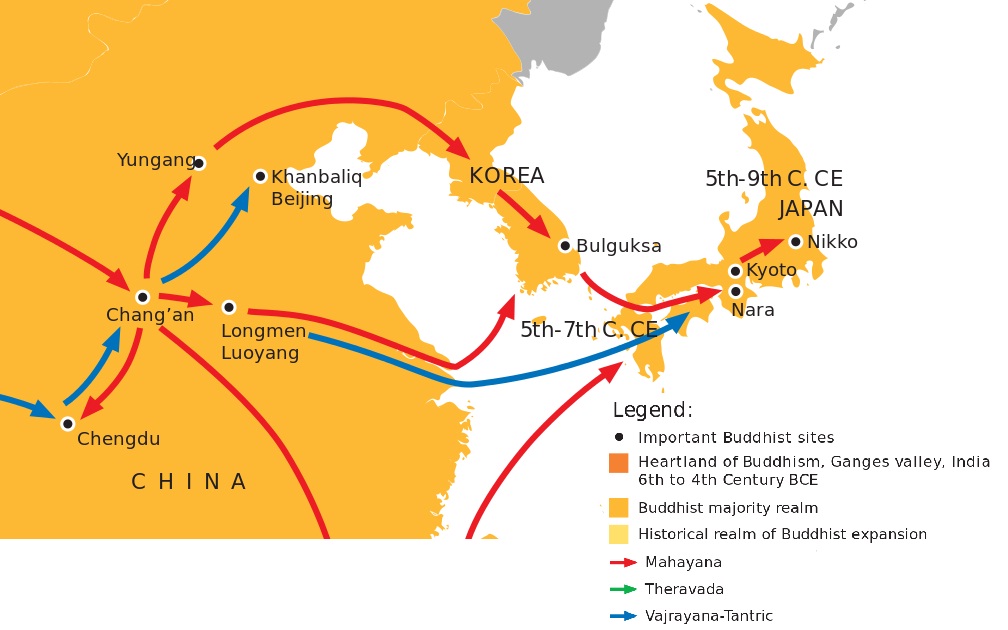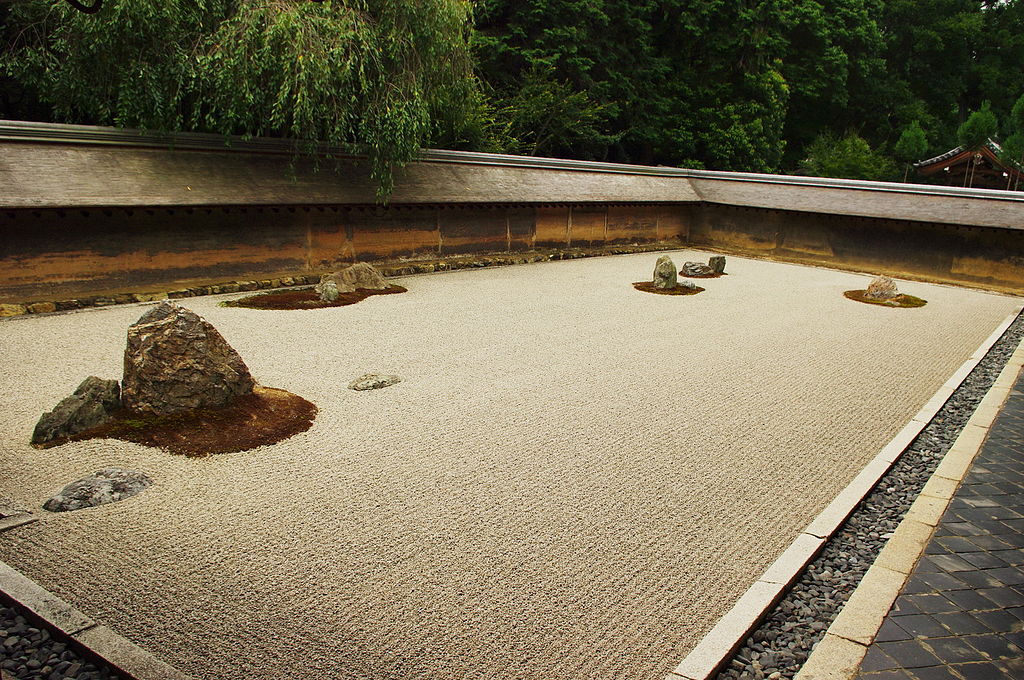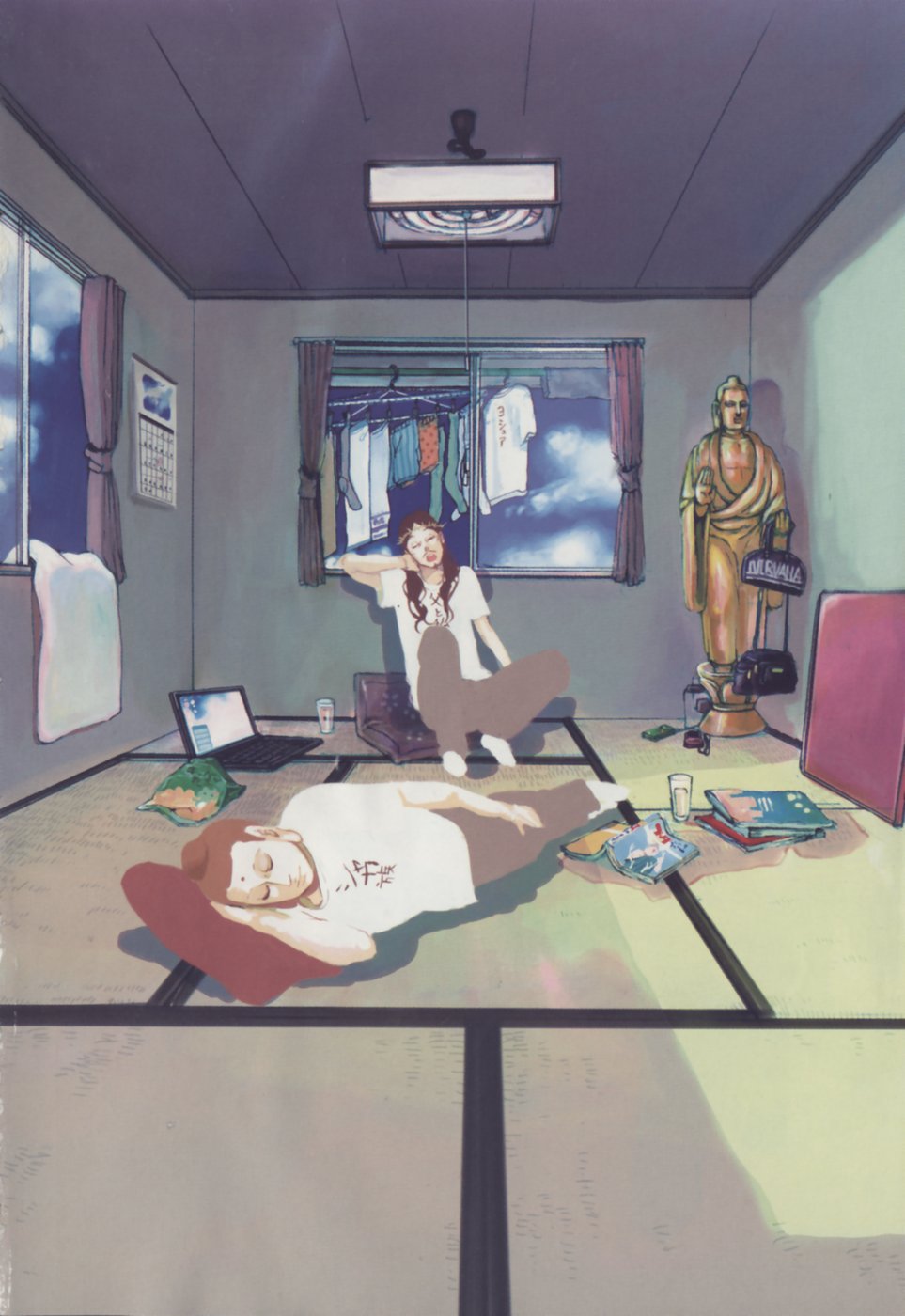4. Buddhism in Japan
map of Buddhism diffusion in Japan

Modified version of
http://en.wikipedia.org/wiki/History_of_Buddhism#mediaviewer/File:Buddhist_Expansion.svg
by Gunawan Kartapranata
Created: January 31, 2014
CC BY-SA 3.0
A map of the diffusion of Buddhism from China to Japan from the 5th to the 9th cen. CE.
Excerpts from the Tannishō
(ch. 3)
Even the good person attains birth in the Pure Land, how much more so the evil person.
But the people of the world constantly say, even the evil person attains birth, how much more so the good person. Although this appears to be sound at first glance, it goes against the intention of the Primal Vow of Other Power. The reason is that since the person of selfpower, being conscious of doing good, lacks the thought of entrusting the self completely to Other Power, he or she is not the focus of the Primal Vow of Amida. But when self-power is turned over and entrusting to Other Power occurs, the person attains birth in the land of True Fulfillment.
The Primal Vow was established out of deep compassion for us who cannot become freed from the bondage of birth-and-death through any religious practice, due to the abundance of blind passion. Since its basic intention is to effect the Enlightenment of such an evil one, the evil person who is led to true entrusting by Other Power is the person who attains birth in the Pure Land. Thus, even the good person attains birth, how much more so the evil person!
(ch. 8)
The saying of nembutsu is neither a religious practice nor a good act. Since it is practiced without any calculation, it is "non-practice." Since it is also not a good created by my calculation, it is "non-good." Since it is nothing but Other Power, completely free of selfpower, it is neither a religious practice nor a good act on the part of the practicer
Translation by Unno Taisetsu
retrieved in
http://www.livingdharma.org/Tannisho/TannishoChaptersI-X.html
Two excerpts from the Tannishō, 13th century short Buddhist text generally thought to have been written by a disciple of Shinran, founder of the Jōdō Shinshū, one of the most most widely practiced branch of Pure Land Buddhism in Japan, based on the belief of rebirth in the Pure Land, a Buddhist Paradise.
Excerpt from the Shōbōgenzō
To think practice and realization are not one is a non-Buddhist view. In the Buddha-Dharma [i.e. Buddhism], practice and realization are one and the same. As your present practice is practice within realization, your initial negotiation of the Way [of Buddhism] is in itself the whole of original realization. That is why from the time you are instructed in the way of practice, you are told not to expect realization apart from practice.
Translated by Norman Waddel and Masao Abe, "The Heart of Dōgen's Shōbōgenzō", State University of New York Press, Albany, 2002, p. 19, translation slightly altered
A excerpt from the Shōbōgenzō, a collection of works written by Eihei Dōgen, the 13th century Japanese Buddhist monk and founder of the Sōtō school of Japanese Zen, and one of the foremost thinker of medieval Japan.
Japanese Haiku
This dewdrop world
Is a dewdrop world,
And yet, and yet...
Mackenzie, Lewis, trans. (1984). The Autumn Wind: A Selection from the Poems of Issa. Kodansha International
An haiku (typical Japanese short poem) written by Kobayashi Issa (1763 - 1828), a Japanese poet and lay Buddhist priest of the Jōdō Shinshū sect. He is one of the most famous haiku poet of Japan.
Sand Garden at Ryoanji

CC 3.0 retrieved in
http://commons.wikimedia.org/wiki/File:JP-kyoto-ryoanji.jpg
The famous sand garden of the Ryoanji, a Zen Temple located in Kyoto, Japan. This "dry landscape" garden is thought to have been built in the late 15th century. The garden is a rectangle of 248 square meters. Placed within it are fifteen stones of different sizes, composed in five groups; The stones are surrounded by white gravel, which is carefully raked each day by the monks. The only vegetation in the garden is some moss around the stones.
The temple and its gardens are listed as one of the Historic Monuments of Ancient Kyoto, and as a UNESCO World Heritage Site.
Buddha and Jesus in japanese comic

© Kodansha
A page of the manga (japanese comics) entitled "Young Saint Man", written by Nakamura Hikaru (1983). This manga tells the adventure of Buddha and Jesus descended on earth, in present-day Tokyo, for a vacation.
This series has been localized in languages including Chinese, French, Italian and Spanish.
A Buddhist Chant of a Pure Land School
A Buddhist Chant of a Pure Land Buddhist School, saying "Namu Amida" (Glory to Buddha Amida).
Japanese Buddhist Chant (audio) - ©Ongaku no tomo corp. Tokyo






